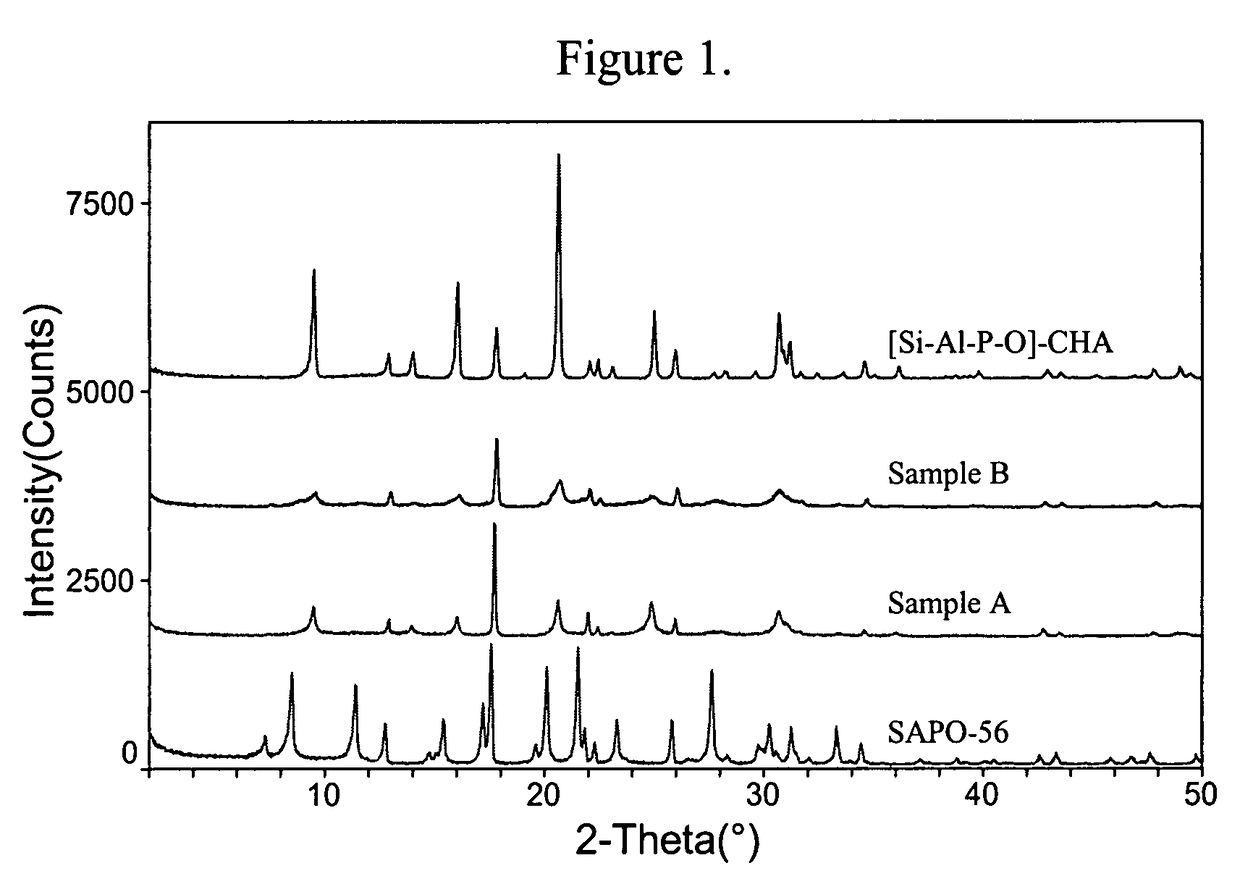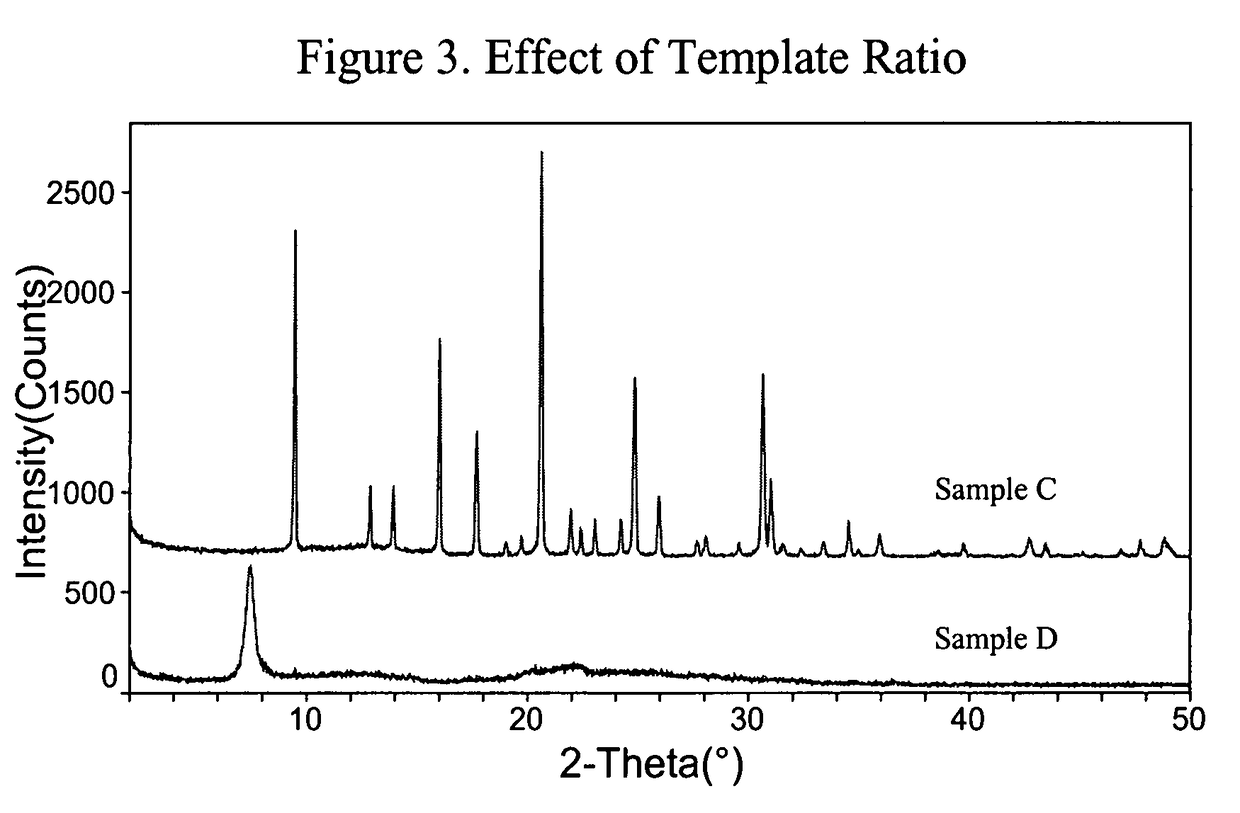Intergrown molecular sieve, its synthesis and its use in the conversion of oxygenates to olefins
a technology of intergrown molecular sieves and molecular slurry, which is applied in the direction of physical/chemical process catalysts, hydrocarbon oil treatment products, silicon compounds, etc., can solve the problems of limiting catalyst life, increasing the potential for undesired secondary reactions, and lowering the diffusion rate of reactants and products
- Summary
- Abstract
- Description
- Claims
- Application Information
AI Technical Summary
Benefits of technology
Problems solved by technology
Method used
Image
Examples
example 1
(Comparative) Synthesis of [Si—Al—P—O]-CHA with DMCHA
[0096]The following ingredients were mixed, in sequence, and blended into a uniform gel using a microhomogenizer (Tissue Tearor Model 98730, available from Biospec Products, Inc, USA): 85 wt % H3PO4 (obtained from Aldrich Chemical Company), deionized H2O, Catapal™ A (73.9 wt % Al2O3, available from CONDEA Vista Company, Texas, USA), Cabosil™ (Cabot Company, USA), and then N,N-dimethylcyclohexylamine (DMCHA) (Aldrich Chemical Company, USA). The molar ratios of the ingredients were as follows:
[0097]1.5 DMCHA: 1.0 Al2O3:1.0 P2O5:0.1SiO2:45H2O
[0098]The gel was heated in a sealed Teflon-lined Parr autoclave at 170° C. for 3 days while being tumbled at 40 rpm. The solid product was recovered and purified by centrifugation and washing with deionized water. The XRD of the powder product is given in FIG. 1 and indicated that the product was pure and had the CHA framework type.
example 2
(Comparative) Synthesis of SAPO-56 with TMHDA
[0099]The same ingredients and mixing sequence as in Example 1 were employed, except that N,N,N′,N′-tetramethylhexane-1,6-diamine (TMHDA) (Aldrich) was added as template. The molar ratios of the gel composition were as follows:
[0100]1.5 TMHDA:1.0 Al2O3:1.0 P2O5:0.45SiO2:40H2O
[0101]The gel was heated with no agitation at 170° C. for 5 days followed by 200° C. for three days. The solid product similarly was recovered in Example 1, and was confirmed to be SAPO-56 as indicated by its XRD pattern (see FIG. 1).
example 3
Synthesis of AFX / CHA Intergrowths
[0102]The same ingredients and mixing sequence as in Example 1 were employed, except that both DMCHA and TMHDA were used as templates. Two gel compositions, Samples A and B, were produced and had the following molar ratios:[0103]0.8 DMCHA:1.1TMHDA:1.0 Al2O3:1.0 P2O5:0.6SiO2:40H2O for Sample A,[0104]0.6 DMCHA:1.2TMHDA:1.0 Al2O3:1.0 P2O5:0.6SiO2:40H2O for Sample B
[0105]The gels were heated with no agitation at 180° C. for one day, followed by tumbling (40 rpm) at 180° C. for 10 days, and then without agitation again at 200° C. for three days. The XRD patterns of both Samples A and B are shown in FIG. 1.
[0106]FIG. 1 shows that the XRDs of Samples A and B resemble that of [Si—Al—P—O]-CHA, not that of SAPO-56. The peak profile and intensities, however, are quite different from that of the [Si—Al—P—O]-CHA. Particularly noteworthy is the coexistence of sharp and broad peaks.
[0107]A closer inspection of the peaks of Sample A (same with Sample B, but not show...
PUM
| Property | Measurement | Unit |
|---|---|---|
| molar ratio | aaaaa | aaaaa |
| angle | aaaaa | aaaaa |
| molar ratio | aaaaa | aaaaa |
Abstract
Description
Claims
Application Information
 Login to View More
Login to View More - R&D
- Intellectual Property
- Life Sciences
- Materials
- Tech Scout
- Unparalleled Data Quality
- Higher Quality Content
- 60% Fewer Hallucinations
Browse by: Latest US Patents, China's latest patents, Technical Efficacy Thesaurus, Application Domain, Technology Topic, Popular Technical Reports.
© 2025 PatSnap. All rights reserved.Legal|Privacy policy|Modern Slavery Act Transparency Statement|Sitemap|About US| Contact US: help@patsnap.com



